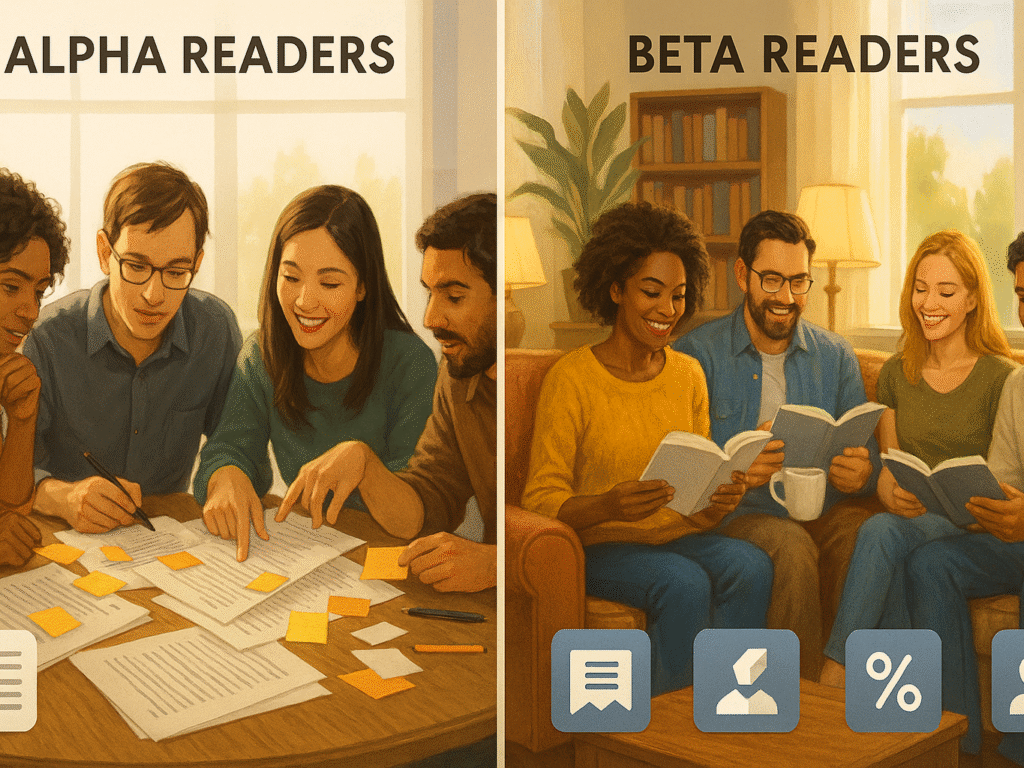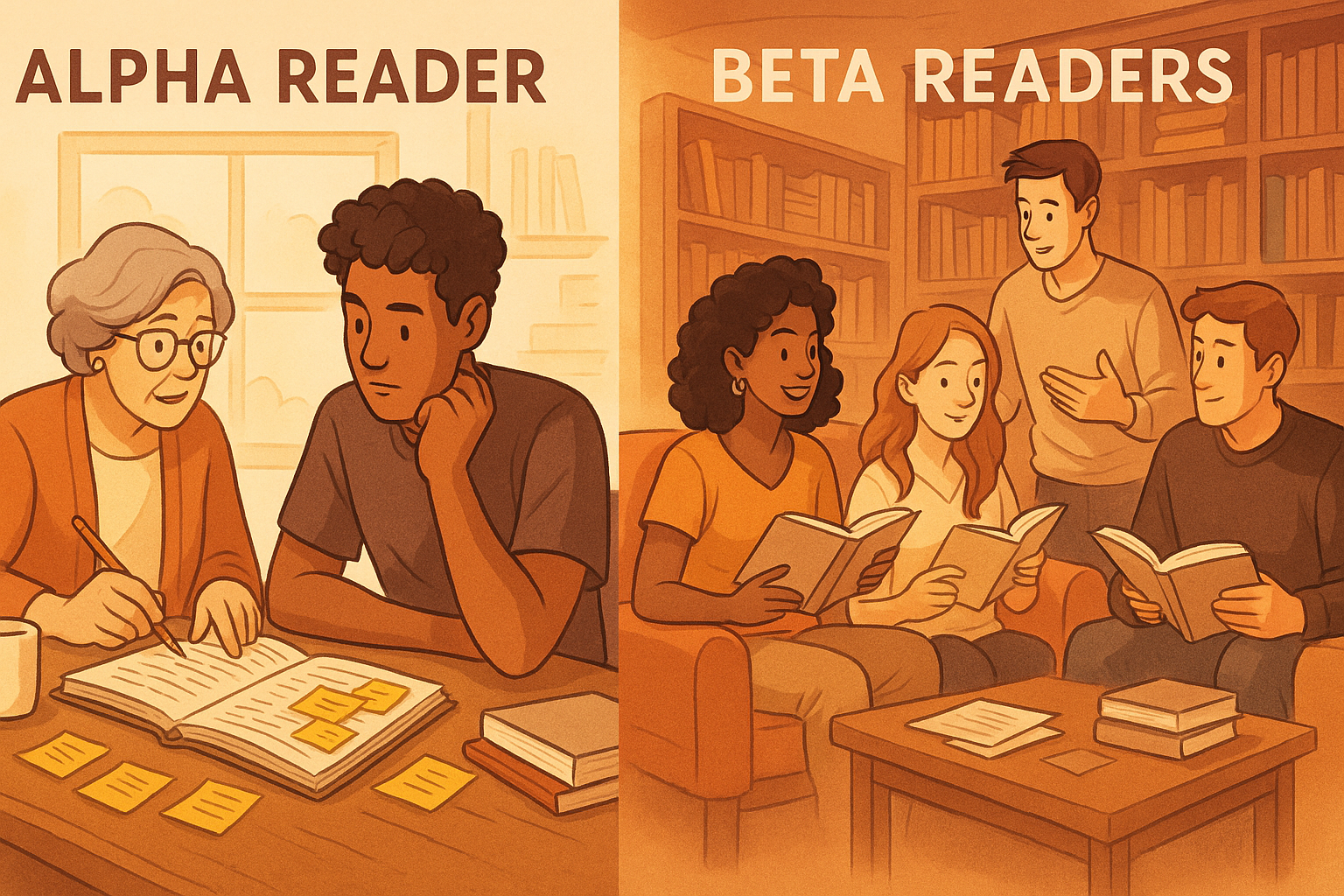When considering alpha readers vs beta readers for your manuscript, you’re following in the footsteps of literary giants. T.S. Eliot and Ezra Pound shared their writing, while Hemingway, F. Scott Fitzgerald, and Gertrude Stein regularly exchanged feedback on their work. This tradition of seeking different perspectives continues today, but understanding which type of reader you need, and when, can significantly impact your book’s development.
So, what exactly is an alpha reader? Essentially, an alpha reader is the first person to see your brand-new manuscript, approaching your work from a writer’s perspective to help identify plot holes and disjointed edges. Unlike beta readers, who come after alpha readers and typically read your story just once, alpha readers focus on general story issues like awkward dialogue and incomplete characterization—understanding alpha readers vs beta readers and their distinct purposes during your writing journey, with the alpha reader meaning early-stage feedback and the beta readers providing a more impartial perspective from people who ddon’tnecessarily have a vested interest in your success.
Whether you’re finishing your first draft or polishing a revised manuscript, knowing when to use each type of reader can make the difference between a good book and a great one. In this guide, we’ll break down exactly what these readers do, when to bring them in, and how to maximize their feedback.
Comparison Table: Alpha Readers vs Beta Readers
| Aspect | Alpha Readers | Beta Readers |
| Reading Stage | First to see manuscript; early/rough drafts | After initial revisions, more polished drafts |
| Reader Background | Often, fellow writers with story craft knowledge | Typical readers with no specific writing expertise |
| Main Focus | Plot structure, character development, narrative flow, plot holes | Reader experience, engagement, emotional connection |
| Recommended Number | 3-5 readers | 2-4 readers |
| Type of Feedback | Story structure, plot holes, character believability, and pacing issues | Overall impressions, points of confusion, and reading experience |
| Primary Purpose | Identify structural issues and guide major revisions | Simulate actual reader experience and fine-tune manuscript |
| Reading Frequency | May read multiple versions/chapters | Typically, read a story once |
| Perspective | Writer’s perspective | Consumer’s perspective |
| Timing in Process | First stage of external feedback | After alpha reader revisions are complete |
| Focus Level | Big-picture elements | Reader experience and engagement |
The Role of Alpha Readers in Early Drafts

When examining alpha readers vs beta readers, alpha readers provide early, high-level feedback on your rough draft, helping shape the plot, characters, and pacing. They guide foundational revisions before polishing begins, ensuring that your story structure is effective. Their insight helps prevent deeper issues later in the writing process.
1. What is an alpha reader, and when to use one
Alpha readers serve as your manuscript’s first “taste testers” beyond your own eyes. They read your story in its earliest form, often a rough first draft or even chapter-by-chapter as you write. Think of them as your initial sounding board before any major revisions or polishing takes place.
Ideally, you should engage alpha readers after completing your rough draft or when you’re feeling stuck with your narrative direction. These readers approach your work from a writer’s perspective rather than just as consumers of the final product. Many successful authors consider alpha readers essential for any writing intended for publication.
The best alpha readers understand story structure and can provide honest feedback without being harsh. They should align with your target audience and understand the genre positioning of your book. Although trusted friends or family members can serve this role, experienced alpha readers offer more comprehensive insights into the nuances of alpha readers vs beta readers.
2. How alpha readers help shape your story
Alpha readers focus primarily on your story’s big-picture elements instead of grammar or spelling errors. Their attention centers on:
- Plot structure and narrative flow
- Character development and believability
- Pacing and engagement level
- Identifying plot holes and logical inconsistencies
- Overall story concept and direction
One key benefit in the alpha readers vs beta readers debate is that alpha readers provide an objective perspective. Since first drafts are typically messy with fragmented ideas, having outside opinions helps guide you toward the strongest parts of your story. Additionally, they identify areas that require further development, such as unconvincing magic systems or thin settings.
In the alpha vs beta readers framework, alpha readers prove particularly valuable in verifying whether characters you love come across as lovable on the page. Furthermore, they can save you from spending months revising a fundamentally flawed narrative that needs complete restructuring.
3. Examples of alpha reader feedback
Alpha reader comments typically address core storytelling elements rather than line-level corrections. Their feedback might include observations like:
- “The subplot is competing too heavily with the main plot.”
- “Your secondary character seems more interesting than your protagonist.”
- “The story would work better in third person instead of first person.”
- “That subplot disappears after Chapter 5 without resolution.”
Many writers navigating alpha readers vs beta readers find that working with 3-5 trusted alpha readers provides the ideal balance of perspectives. However, determining the right number depends on your manuscript’s complexity and your confidence level. Historical examples show the value of this approach.
Mary Shelley wrote Frankenstein as part of a writing challenge with Percy Shelley, Lord Byron, and John Polidori, who all exchanged stories and provided feedback that proved crucial to the final work.
Alpha readers ultimately help you see what your story might become, not just what it currently is. They provide a roadmap for revisions before you invest substantial time polishing prose that might need structural changes.
How Many Beta Readers Should I Have? The number of beta readers significantly impacts the quality of your feedback and the revision process. Learn the optimal reader count for different manuscript types, how to manage multiple perspectives, and how to avoid feedback overload.
Using Beta Readers After Revisions

In the alpha readers vs beta readers sequence, beta readers offer a fresh, reader-focused perspective after early revisions are complete. They simulate your target audience’s experience, helping refine pacing, engagement, and clarity. Their insights guide final improvements before submission to editors, agents, or self-publishing platforms.
1. What is a beta reader and their role in polishing
Once your manuscript has undergone initial revisions, beta readers step in as your book’s “test audience.” Unlike alpha readers who focus on story structure, beta readers typically approach your work as ordinary readers with little or no expertise on story craft or publishing. Their primary purpose is to provide a reader’s perspective, an invaluable viewpoint that helps predict how your actual audience might respond.
Beta readers don’t tell you whether your plot conforms to a three-act structure or if your characters have enough internal conflict. Instead, they reveal which characters they connected with, where they lost interest, and whether your ending felt satisfying or frustrating. This feedback in the alpha vs beta readers process helps you polish your manuscript before sending it to editors or agents.
7 Best Places To Find Beta Readers For Hire (Professional Services Compared): Finding quality beta readers can be challenging, but professional services offer reliable, experienced feedback. Compare top platforms, pricing, and service quality to find the ideal beta readers for your manuscript, considering your genre and budget.
2. How beta readers simulate real reader experience
The magic of beta readers lies in their ability to simulate a consumer’s experience. To maximize this benefit, avoid biasing them with information about your story beforehand. Ideally, they should see what a customer would see, experiencing your work as a casual reader would.
Most writers understand that alpha readers vs beta readers benefit from having multiple beta readers (typically 2-4) to collect diverse perspectives. Professional beta reading services can provide this diversity when personal networks fall short. This approach helps identify which reactions are typical versus those that are anomalies. If one reader misinterprets something, it might be an isolated case; however, if multiple readers share the same confusion, you’ve identified a genuine issue requiring attention.
Beta readers are most effective for manuscripts that already have considerable polish and refinement. Hence, they’re an excellent follow-up to editing when your book is close to its final form.
Beta Readers for Novels: Novel manuscripts require specialized beta reader expertise that differs from that of short stories or non-fiction. Discover genre-specific considerations, reader selection criteria, and feedback strategies explicitly tailored for novel-length fiction projects.
3. Common beta reader questions to ask
Providing structured feedback questions helps both you and your beta readers. Since they’re not qualified editors, they often don’t know what to focus on. Consider asking:
- “What was your overall impression of the story?”
- “Did the story grab you at the beginning?”
- “Were there any points where you started to lose interest?”
- “Was there anything particular that you found confusing?”
- “Did you notice any inconsistencies in the plot or with the characters?”
- “Did you find the ending satisfying?”
For character-specific feedback, ask which characters they found most and least engaging, and why. Additionally, include genre-specific questions about worldbuilding for fantasy or historical authenticity for period pieces.
When managing alpha readers vs beta readers’ feedback, remember you don’t need to act on every piece of feedback. Nevertheless, if multiple beta readers point out the same issue, it deserves your attention.
Why Most Writers Get Beta Readers Wrong: Many writers make critical mistakes when working with beta readers, leading to unhelpful feedback and wasted time. Learn the common pitfalls, timing errors, and communication issues that sabotage the beta reading process.
Alpha Readers vs Beta Readers: Which Comes First and Why

Alpha readers come first, reviewing early drafts for structural issues, while beta readers follow later, offering reader-focused feedback on polished manuscripts. Using both ensures a well-rounded editing process, guiding your story from raw concept to final, audience-ready form.
1. Alpha reader vs beta reader: order of operations
The alpha readers vs beta readers order follows logic: just as A comes before B in the alphabet, alpha readers naturally precede beta readers in the manuscript development process. This alpha vs beta readers sequence isn’t arbitrary; it reflects the logical progression of manuscript refinement.
Alpha readers typically review your earliest drafts, often seeing your work immediately after your initial self-editing. They examine your manuscript when it’s still rough around the edges, looking for fundamental issues that need addressing before more detailed polishing begins.
Subsequently, beta readers enter the picture once you’ve implemented revisions based on alpha reader feedback. They approach your work when it’s in a more polished state, reading it as typical readers would, not as fellow writers analyzing craft elements. This progression enables your manuscript to evolve systematically from broad structural improvements to more refined details.
2. Why are both important for different stages
The alpha readers vs beta readers approach shows that both serve distinctly different yet complementary purposes throughout your writing journey. Alpha readers function as writer-readers who help identify plot holes, character inconsistencies, and structural weaknesses. They approach your work intending to improve its foundational elements, the storytelling bones beneath the prose.
Conversely, beta readers simulate the experience of your target audience. Their primary value comes from providing a fresh perspective on how your story feels to someone encountering it for the first time. However, many writers make crucial mistakes in how they approach and manage beta readers. Moreover, they can identify lingering issues that might have been overlooked in earlier revisions or new problems that emerged during rewrites.
3. Can you skip one of them?
The question of whether you can bypass either alpha or beta readers depends mainly on your specific circumstances and manuscript needs. Specifically, if your writing skills are still developing, skipping alpha readers might be problematic; beta readers could become too distracted by fundamental writing issues to provide helpful feedback on the reading experience.
Accordingly, some writers with strong technical skills jump straight to beta readers if they’re confident in their story structure. Otherwise, critique partners or developmental editors sometimes fill the alpha reader role, especially if finding dedicated alpha readers proves challenging.
For best results, the alpha readers vs beta readers approach of incorporating both types of feedback provides the most comprehensive manuscript development path. Understanding how many beta readers you should have at each stage ensures you get balanced feedback without overwhelming yourself with conflicting opinions.
Free Beta Readers: Budget-conscious authors can find excellent beta readers without spending money. Explore community platforms, writer groups, and reciprocal arrangements that provide quality feedback while building lasting writing relationships.
Working with Feedback: Best Practices

Receiving alpha readers’ vs beta readers’ feedback presents a unique challenge: how to transform diverse opinions into actionable improvements without becoming overwhelmed. Mastering this process can make the difference between a good book and an exceptional one.
1. How to handle conflicting feedback
Receiving contradictory comments is virtually inevitable in the feedback process. One alpha reader might love your protagonist while another finds them unlikable. To navigate these contradictions effectively:
In alpha vs beta readers’ feedback, look for patterns across multiple readers rather than focusing on individual comments if three out of five readers mention that a character feels flat, even in different ways, that signals an issue worth addressing.
Consider the source when weighing feedback. Comments from readers who understand your genre typically deserve more consideration than those from readers unfamiliar with books like yours.
Identify the underlying problem beyond specific suggestions. If one reader suggests cutting a character while another recommends developing them further, the core issue might be that the character feels purposeless in your story.
2. Setting deadlines and expectations
Clear communication with your alpha and beta readers helps ensure timely, helpful feedback:
Provide reasonable timeframes for manuscript review; 4-6 weeks is generally recommended for standard-length manuscripts. Communicate whether deadlines are firm or flexible.
Send occasional check-in emails as deadline reminders, without overwhelming readers with excessive communication.
Remember that your readers are doing you a favor. Express gratitude for their time, regardless of whether you agree with all their suggestions.
3. Avoiding feedback overload
With multiple readers providing input, staying focused becomes challenging:
Categorize feedback using a simple framework: universal issues (mentioned by multiple readers), critical elements (affecting core story components), stylistic preferences, and personal reactions.
Wait to read all feedback until after your scheduled deadline. It allows you to compile and sort through responses without fixating on any single reader’s opinion.
Consider bringing in a professional editor or a fresh perspective if you are truly caught between contradictory feedback, someone who can break the deadlock with expertise and emotional distance.
Throughout this process, maintain your vision as the creator of the story. As Neil Gaiman noted, “When people tell you something’s wrong, they are almost always right. When they tell you exactly how to fix it, they are almost always wrong.”
Critique Partners and Editors: How They Fit In

Beyond alpha and beta readers lies a broader ecosystem of feedback providers that can elevate your manuscript to professional standards.
1. What is a critique partner, and how do they differ
Critique partners (CPs) occupy a unique position in your writing journey. Unlike alpha or beta readers, critique partners form a reciprocal relationship where you exchange manuscripts and provide mutual feedback. This writer-to-writer arrangement creates a dynamic different from one-way reading relationships.
CPs differ from alpha readers as they typically review semi-revised manuscripts rather than raw first drafts. They’re always fellow writers who understand storytelling mechanics from a creator’s perspective. Many writers describe finding the right critique partner as similar to dating; you need someone whose strengths complement your weaknesses and who understands your genre.
The best critique partners provide specific feedback about what isn’t working, why it isn’t working, and potential solutions, offering deeper craft insights than most beta readers can provide.
2. When to bring in a professional editor
Professional editing becomes valuable once you’ve exhausted feedback from critique partners, alpha, and beta readers. Editors bring specialized training that friends, family, and even fellow writers typically lack.
Consider hiring an editor when:
- You’ve revised extensively, but still feel something’s missing
- You’re receiving consistent rejections without clear revision guidance
- You’re planning to self-publish and need professional polish
For self-publishing, a complete editing process ideally includes developmental editing, line editing, and finally copyediting, in that specific order. These services range widely in cost and approach, with sound editors charging $2,000 to $ 4,000 for comprehensive manuscript work.
3. Combining feedback sources effectively
To manage feedback from multiple sources without becoming overwhelmed:
First, organize comments into categories like plot, character, and pacing to identify patterns across different readers. Pay particular attention when multiple readers point out the same issue.
Second, limit yourself to 1-3 people at each feedback stage to avoid too many conflicting opinions. Remember that the alpha vs beta readers approach, combined with critique partners, provides a balanced perspective throughout your writing process.
Finally, address one issue at a time rather than attempting wholesale revisions based on all feedback simultaneously. This methodical approach prevents the paralysis that often comes from conflicting suggestions.
Final Thoughts
Throughout the writing journey, feedback acts as your creative compass, refining your manuscript from raw concept to polished prose. The alpha readers vs beta readers system shows that both play essential roles in this process, each offering distinct input. Their timing, purpose, and insight guide your writing through different stages of development with clarity and depth.
Alpha readers come first, identifying major structural issues, such as plot inconsistencies or weak character arcs. They help shape the foundation before you invest too deeply. Once those revisions are in place, beta readers step in to provide a reader’s view, offering reactions and suggestions based on the story’s overall flow and impact.
Using both isn’t an either-or decision; it’s a strategic choice. Alpha readers help you build the structure, beta readers help you decorate and test it. Supplement their feedback with critique partners and professional editors to cover all angles. This well-rounded approach honors the creative process and helps elevate your manuscript to a publishable level.
FAQs
Q1. What is the primary role of alpha readers?
Alpha readers help shape your manuscript in its rawest form. They focus on structure, plot logic, and character development. Their feedback often reveals major issues early, such as inconsistencies or unclear motivations, helping you correct foundational problems before deeper revisions or polishing take place.
Q2. When should you engage alpha readers?
You should involve alpha readers as soon as your rough draft is complete or when you’re stuck creatively. Their early input helps determine whether your core story works. By catching structural flaws early, they save you from investing time editing scenes that may need complete rewrites later.
Q3. How do beta readers differ from alpha readers?
Beta readers review your manuscript after major revisions are done. Unlike alpha readers, they approach your work as casual readers would, focusing more on how engaging, emotional, or enjoyable the story is. Their feedback reflects the potential reactions of your target audience, offering valuable insights into the reader experience.
Q4. What type of feedback do beta readers provide?
Beta readers comment on clarity, pacing, character connection, and overall impact. They may highlight confusing parts, disengaging scenes, or unresolved questions. Their role is to help ensure the story reads smoothly and feels emotionally satisfying before submission, serving as the final step in the alpha readers vs beta readers feedback loop.


